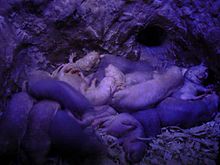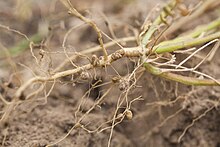Charles Darwin mentioned evolutionary interactions between flowering plants and insects in On the Origin of Species (1859). The term coevolution was coined by Paul R. Ehrlich and Peter H. Raven in 1964. The theoretical underpinnings of coevolution are now well-developed, and demonstrate that coevolution can play an important role in driving major evolutionary transitions such as the evolution of sexual reproduction or shifts in ploidy. More recently, it has also been demonstrated that coevolution influences the structure and function of ecological communities as well as the dynamics of infectious disease.
Each party in a coevolutionary relationship exerts selective pressures on the other, thereby affecting each other's evolution. Coevolution includes many forms of mutualism, host-parasite, and predator-prey relationships between species, as well as competition within or between species. In many cases, the selective pressures drive an evolutionary arms race between the species involved. Pairwise or specific coevolution, between exactly two species, is not the only possibility; in guild or diffuse coevolution, several species may evolve a trait in reciprocity with a trait in another species, as has happened between the flowering plants and pollinating insects such as bees, flies, and beetles.
Coevolution is primarily a biological concept, but researchers have applied it by analogy to fields such as computer science, sociology, and astronomy.
Mutualism
Coevolution is the evolution of two or more species which reciprocally affect each other, sometimes creating a mutualistic relationship between the species. Such relationships can be of many different types.Flowering plants
Flowers appeared and diversified relatively suddenly in the fossil record, creating what Charles Darwin described as the "abominable mystery" of how they had evolved so quickly; he considered whether coevolution could be the explanation. He first mentioned coevolution as a possibility in On the Origin of Species, and developed the concept further in Fertilisation of Orchids (1862).Insects and entomophilous flowers
Honey bee taking a reward of nectar and collecting pollen in its pollen baskets from white melilot flowers
Modern insect-pollinated (entomophilous) flowers are conspicuously coadapted with insects to ensure pollination and in return to reward the pollinators with nectar and pollen. The two groups have coevolved for over 100 million years, creating a complex network of interactions. Either they evolved together, or at some later stages they came together, likely with pre-adaptations, and became mutually adapted. The term coevolution was coined by Paul R. Ehrlich and Peter H. Raven in 1964, to describe the evolutionary interactions of plants and butterflies.
Several highly successful insect groups—especially the Hymenoptera (wasps, bees and ants) and Lepidoptera (butterflies) as well as many types of Diptera (flies) and Coleoptera (beetles)—evolved in conjunction with flowering plants during the Cretaceous (145 to 66 million years ago). The earliest bees, important pollinators today, appeared in the early Cretaceous. A group of wasps sister to the bees evolved at the same time as flowering plants, as did the Lepidoptera. Further, all the major clades of bees first appeared between the middle and late Cretaceous, simultaneously with the adaptive radiation of the eudicots (three quarters of all angiosperms), and at the time when the angiosperms became the world's dominant plants on land.
At least three aspects of flowers appear to have coevolved between flowering plants and insects, because they involve communication between these organisms. Firstly, flowers communicate with their pollinators by scent; insects use this scent to determine how far away a flower is, to approach it, and to identify where to land and finally to feed. Secondly, flowers attract insects with patterns of stripes leading to the rewards of nectar and pollen, and colours such as blue and ultraviolet, to which their eyes are sensitive; in contrast, bird-pollinated flowers tend to be red or orange. Thirdly, flowers such as some orchids mimic females of particular insects, deceiving males into pseudocopulation.
The yucca, Yucca whipplei, is pollinated exclusively by Tegeticula maculata, a yucca moth that depends on the yucca for survival. The moth eats the seeds of the plant, while gathering pollen. The pollen has evolved to become very sticky, and remains on the mouth parts when the moth moves to the next flower. The yucca provides a place for the moth to lay its eggs, deep within the flower away from potential predators.
Birds and ornithophilous flowers
Purple-throated carib feeding from and pollinating a flower
Hummingbirds and ornithophilous (bird-pollinated) flowers have evolved a mutualistic relationship. The flowers have nectar suited to the birds' diet, their color suits the birds' vision and their shape fits that of the birds' bills. The blooming times of the flowers have also been found to coincide with hummingbirds' breeding seasons. The floral characteristics of ornithophilous plants vary greatly among each other compared to closely related insect-pollinated species. These flowers also tend to be more ornate, complex, and showy than their insect pollinated counterparts. It is generally agreed that plants formed coevolutionary relationships with insects first, and ornithophilous species diverged at a later time. There is not much scientific support for instances of the reverse of this divergence: from ornithophily to insect pollination. The diversity in floral phenotype in ornithophilous species, and the relative consistency observed in bee-pollinated species can be attributed to the direction of the shift in pollinator preference.
Flowers have converged to take advantage of similar birds. Flowers compete for pollinators, and adaptations reduce unfavourable effects of this competition. The fact that birds can fly during inclement weather makes them more efficient pollinators where bees and other insects would be inactive. Ornithophily may have arisen for this reason in isolated environments with poor insect colonization or areas with plants which flower in the winter. Bird-pollinated flowers usually have higher volumes of nectar and higher sugar production than those pollinated by insects. This meets the birds' high energy requirements, the most important determinants of flower choice. In Mimulus, an increase in red pigment in petals and flower nectar volume noticeably reduces the proportion of pollination by bees as opposed to hummingbirds; while greater flower surface area increases bee pollination. Therefore, red pigments in the flowers of Mimulus cardinalis may function primarily to discourage bee visitation. In Penstemon, flower traits that discourage bee pollination may be more influential on the flowers' evolutionary change than 'pro-bird' adaptations, but adaptation 'towards' birds and 'away' from bees can happen simultaneously. However, some flowers such as Heliconia angusta appear not to be as specifically ornithophilous as had been supposed: the species is occasionally (151 visits in 120 hours of observation) visited by Trigona stingless bees. These bees are largely pollen robbers in this case, but may also serve as pollinators.
Following their respective breeding seasons, several species of hummingbirds occur at the same locations in North America, and several hummingbird flowers bloom simultaneously in these habitats. These flowers have converged to a common morphology and color because these are effective at attracting the birds. Different lengths and curvatures of the corolla tubes can affect the efficiency of extraction in hummingbird species in relation to differences in bill morphology. Tubular flowers force a bird to orient its bill in a particular way when probing the flower, especially when the bill and corolla are both curved. This allows the plant to place pollen on a certain part of the bird's body, permitting a variety of morphological co-adaptations.
A fig exposing its many tiny matured, seed-bearing gynoecia. These are pollinated by the fig wasp, Blastophaga psenes. In the cultivated fig, there are also asexual varieties.
Fig reproduction and fig wasps
The genus Ficus is composed of 800 species of vines, shrubs, and trees, including the cultivated fig, defined by their syconiums, the fruit-like vessels that either hold female flowers or pollen on the inside. Each fig species has its own fig wasp which (in most cases) pollinates the fig, so a tight mutual dependence has evolved and persisted throughout the genus.Acacia ants and acacias
Pseudomyrmex ant on bull thorn acacia (Vachellia cornigera) with Beltian bodies that provide the ants with protein
The acacia ant (Pseudomyrmex ferruginea) is an obligate plant ant that protects at least five species of "Acacia" (Vachellia) from preying insects and from other plants competing for sunlight, and the tree provides nourishment and shelter for the ant and its larvae. Such mutualism is not automatic: other ant species exploit trees without reciprocating, following different evolutionary strategies. These cheater ants impose important host costs via damage to tree reproductive organs, though their net effect on host fitness is not necessarily negative and, thus, becomes difficult to forecast.
Hosts and parasites
Parasites and sexually reproducing hosts
Host–parasite coevolution is the coevolution of a host and a parasite. A general characterization of many viruses, obligate parasites, is that they coevolved alongside their respective hosts. Correlated mutations between the two species enter them into an evolution arms race. Whichever organism, host or parasite, that cannot keep up with the other will be eliminated from their habitat, as the species with the higher average population fitness survives. This race is known as the Red Queen hypothesis. The Red Queen hypothesis predicts that sexual reproduction allows a host to stay just ahead of its parasite, similar to the Red Queen's race in Through the Looking-Glass: "it takes all the running you can do, to keep in the same place". The host reproduces sexually, producing some offspring with immunity over its parasite, which then evolves in response.The parasite/host relationship probably drove the prevalence of sexual reproduction over the more efficient asexual reproduction. It seems that when a parasite infects a host, sexual reproduction affords a better chance of developing resistance (through variation in the next generation), giving sexual reproduction variability for fitness not seen in the asexual reproduction, which produces another generation of the organism susceptible to infection by the same parasite. Coevolution between host and parasite may accordingly be responsible for much of the genetic diversity seen in normal populations, including blood-plasma polymorphism, protein polymorphism, and histocompatibility systems.
Brood parasites
Brood parasitism demonstrates close coevolution of host and parasite, for example in cuckoos. These birds do not make their own nests, but lay their eggs in nests of other species, ejecting or killing the eggs and young of the host and thus having a strong negative impact on the host's reproductive fitness. Their eggs are camouflaged as eggs of their hosts, implying that hosts can distinguish their own eggs from those of intruders and are in an evolutionary arms race with the cuckoo between camouflage and recognition. Cuckoos are counter-adapted to host defences with features such as thickened eggshells, shorter incubation (so their young hatch first), and flat backs adapted to lift eggs out of the nest.Antagonistic coevolution
Antagonistic coevolution is seen in the harvester ant species Pogonomyrmex barbatus and Pogonomyrmex rugosus, in a relationship both parasitic and mutualistic. The queens are unable to produce worker ants by mating with their own species. Only by crossbreeding can they produce workers. The winged females act as parasites for the males of the other species as their sperm will only produce sterile hybrids. But because the colonies are fully dependent on these hybrids to survive, it is also mutualistic. While there is no genetic exchange between the species, they are unable to evolve in a direction where they become too genetically different as this would make crossbreeding impossible.Predators and prey
Predators and prey interact and coevolve, the predator to catch the prey more effectively, the prey to escape. The coevolution of the two mutually imposes selective pressures. These often lead to an evolutionary arms race between prey and predator, resulting in antipredator adaptations.
The same applies to herbivores, animals that eat plants, and the plants that they eat. In the Rocky Mountains, red squirrels and crossbills (seed-eating birds) compete for seeds of the lodgepole pine. The squirrels get at pine seeds by gnawing through the cone scales, whereas the crossbills get at the seeds by extracting them with their unusual crossed mandibles. In areas where there are squirrels, the lodgepole's cones are heavier, and have fewer seeds and thinner scales, making it more difficult for squirrels to get at the seeds. Conversely, where there are crossbills but no squirrels, the cones are lighter in construction, but have thicker scales, making it more difficult for crossbills to get at the seeds. The lodgepole's cones are in an evolutionary arms race with the two kinds of herbivore.
Sexual conflict has been studied in Drosophila melanogaster (shown mating, male on right).
Competition
Both intraspecific competition, with features such as sexual conflict and sexual selection, and interspecific competition, such as between predators, may be able to drive coevolution.Guild or diffuse coevolution
Long-tongued bees and long-tubed flowers coevolved, whether pairwise or "diffusely" in groups known as guilds.
The types of coevolution listed so far have been described as if they operated pairwise (also called specific coevolution), in which traits of one species have evolved in direct response to traits of a second species, and vice versa. This is not always the case. Another evolutionary mode arises where evolution is still reciprocal, but is among a group of species rather than exactly two. This is called guild or diffuse coevolution. For instance, a trait in several species of flowering plant, such as offering its nectar at the end of a long tube, can coevolve with a trait in one or several species of pollinating insects, such as a long proboscis. More generally, flowering plants are pollinated by insects from different families including bees, flies, and beetles, all of which form a broad guild of pollinators which respond to the nectar or pollen produced by flowers.
Outside biology
Coevolution is primarily a biological concept, but has been applied to other fields by analogy.In algorithms
Coevolutionary algorithms are used for generating artificial life as well as for optimization, game learning and machine learning. Daniel Hillis added "co-evolving parasites" to prevent an optimization procedure from becoming stuck at local maxima. Karl Sims coevolved virtual creatures.In architecture
The concept of coevolution was introduced in architecture by the Danish architect-urbanist Henrik Valeur as an antithesis to the concept of "star-architecture". As the curator of the Danish Pavilion at the 2006 Venice Biennale of Architecture he conceived and orchestrated an exhibition project named 'Co-evolution', awarded the Golden Lion for Best National Pavilion.The exhibition included urban planning projects for the cities of Beijing, Chongqing, Shanghai and Xi'an, which had been developed in collaboration between young professional Danish architects and students and professors and students from leading universities in the four Chinese cities. By creating a framework for collaboration between academics and professionals representing two distinct cultures, it was hoped that the exchange of knowledge, ideas and experiences would stimulate "creativity and imagination to set the spark for new visions for sustainable urban development." Valeur later argued that: "As we become more and more interconnected and interdependent, human development is no longer a matter of the evolution of individual groups of people but rather a matter of the co-evolution of all people."
In technology
Computer software and hardware can be considered as two separate components but tied intrinsically by coevolution. Similarly, operating systems and computer applications, web browsers and web applications.All of these systems depend upon each other and advance step by step through a kind of evolutionary process. Changes in hardware, an operating system or web browser may introduce new features that are then incorporated into the corresponding applications running alongside. The idea is closely related to the concept of "joint optimization" in sociotechnical systems analysis and design, where a system is understood to consist of both a "technical system" encompassing the tools and hardware used for production and maintenance, and a "social system" of relationships and procedures through which the technology is tied into the goals of the system and all the other human and organizational relationships within and outside the system. Such systems work best when the technical and social systems are deliberately developed together.

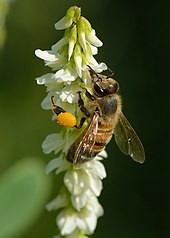


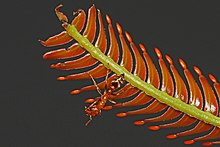





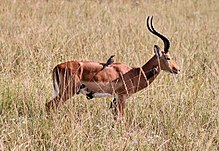
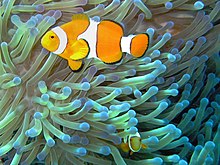
![{\displaystyle {\begin{aligned}{\frac {dN}{dt}}&=r_{1}N\left(1-{\cfrac {N}{K_{1}}}+\beta _{12}{\cfrac {M}{K_{1}}}\right)\\[8pt]{\frac {dM}{dt}}&=r_{2}M\left(1-{\cfrac {M}{K_{2}}}+\beta _{21}{\cfrac {N}{K_{2}}}\right)\end{aligned}}}](https://wikimedia.org/api/rest_v1/media/math/render/svg/4ad5f03b507ef00004738cb5fa57d7b7935816eb)


![{\frac {dN}{dt}}=N\left[r(1-cN)+{\cfrac {baM}{1+aT_{H}M}}\right]](https://wikimedia.org/api/rest_v1/media/math/render/svg/18d5e1d77574628a6fea8238dda57cbfc20d1898)
![{\displaystyle {\frac {dN}{dt}}=N[r(1-cN)+\beta M/(X+M)]}](https://wikimedia.org/api/rest_v1/media/math/render/svg/c37e1855df6b3b221d64349af8299eb47ddc8535)





